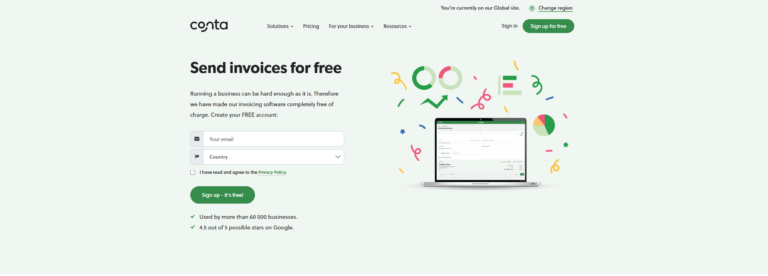Electronic document signing simplifies the way contracts are signed. This article covers everything you should know about e-signatures – from what they are to how they work.
Contracts, agreements, and other important documents often require a signature to prove that the involved parties agree to the content.
A signed contract, binding parties legally to its contents, traditionally involved ink on paper. However, in our digitally evolving landscape, electronic signatures, or e-signatures, have transformed this process, offering a seamless and efficient way to endorse electronic documents.
Create free invoices with Conta
Got a business in Australia? Start making invoices and track your revenue with Conta, right now, for free!
It’s easy to create invoices with Conta. The web-based interface works just as well on your mobile device as your desktop or laptop computer, and you’ll be creating your first invoice within two minutes of creating your user account.
Sign up for free
What are electronic signatures?
An electronic signature, or e-signature, is a digital method for legally signing electronic documents, providing a reliable way to endorse them.
Unlike traditional ‘wet signatures’ on paper contracts, electronic signatures use digital impressions or elements, and they can be created on various devices like desktops, tablets, and mobiles, adapting to the digital landscape.
Is electronic document signing legal in Australia?
In Australia, electronic document signing is unequivocally legal.
The legality of electronic signatures is supported by the Electronic Transactions Act of 1999 (ETA) and its corresponding regulations, the Electronic Transactions Regulations of 2020 (ETR), at the federal level. Additionally, each State and Territory within Australia also acknowledges and recognizes the legal validity of electronic signatures.
How digital signatures work
Electronic signatures operate by employing secure identification methods, often leveraging advanced authentication protocols. This ensures the integrity of the signed document and validates the identity of the signatories.
In practical terms, the process of sending and signing documents is effortless. Users simply upload the document, enter the signer’s email address, and hit send. The signer receives an email with a link, allowing them to sign the document directly from their browser. This streamlined approach enhances the efficiency and convenience of the entire electronic signature process.
What can be signed electronically?
Practically, anything signable on paper can be digitally signed, from lease contracts and employment agreements to general meeting protocols and annual financial statements. The process is applicable in both private and professional contexts, with the signed document bearing legal validity through advanced authentication protocols.
5 major benefits of electronic signatures
1. Efficiency and convenience
Electronic signatures facilitate document signing from anywhere globally, eliminating the need for physical presence. This agility significantly accelerates business transactions, in stark contrast to the cumbersome process of handling physical documents.
2. Legally Binding and Secure
Employing secure methods, such as verification via text messages, electronic signatures carry the same legal weight as traditional signatures. Advanced authentication and encryption protocols ensure the security and integrity of signed documents, safeguarding against tampering.
3. Cost-effective and environmentally friendly
Adopting electronic signatures translates to cost savings by reducing paper, printing, and administrative expenses. This shift also aligns with environmental goals, decreasing paper consumption and waste, making it not only cost-effective but also environmentally sustainable.
4. Enhanced security features
In the digital age, security is paramount. Electronic signatures incorporate advanced security features, including secure identification methods, encryption, and audit trails, fortifying the signing process against fraud and unauthorized access.
How do I save a digitally signed document?
When using a signing service, digitally signed documents are meticulously secured and conveniently accessible for download in PDF format. This PDF not only acts as a legally binding record for the contract but also serves as a tangible proof of transaction




